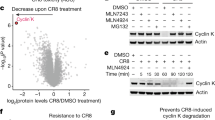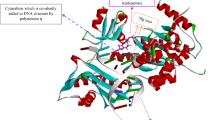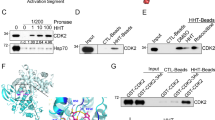Abstract
Aberrant control of cyclin-dependent kinases (CDKs) is a central feature of the molecular pathology of cancer. Iterative structure-based design was used to optimize the ATP- competitive inhibition of CDK1 and CDK2 by O6-cyclohexylmethylguanines, resulting in O6-cyclohexylmethyl-2-(4′- sulfamoylanilino)purine. The new inhibitor is 1,000-fold more potent than the parent compound (Ki values for CDK1 = 9 nM and CDK2 = 6 nM versus 5,000 nM and 12,000 nM, respectively, for O6-cyclohexylmethylguanine). The increased potency arises primarily from the formation of two additional hydrogen bonds between the inhibitor and Asp 86 of CDK2, which facilitate optimum hydrophobic packing of the anilino group with the specificity surface of CDK2. Cellular studies with O6-cyclohexylmethyl-2-(4′- sulfamoylanilino) purine demonstrated inhibition of MCF-7 cell growth and target protein phosphorylation, consistent with CDK1 and CDK2 inhibition. The work represents the first successful iterative synthesis of a potent CDK inhibitor based on the structure of fully activated CDK2–cyclin A. Furthermore, the potency of O6-cyclohexylmethyl-2-(4′- sulfamoylanilino)purine was both predicted and fully rationalized on the basis of protein–ligand interactions.
This is a preview of subscription content, access via your institution
Access options
Subscribe to this journal
Receive 12 print issues and online access
$189.00 per year
only $15.75 per issue
Buy this article
- Purchase on Springer Link
- Instant access to full article PDF
Prices may be subject to local taxes which are calculated during checkout



Similar content being viewed by others
References
Sielecki, T.M., Boylan, J.F., Benfield, P.A. & Trainor, G.L. J. Med. Chem. 43, 1–18 (2000)
Senderowicz, A.M. & Sausville, E.A. J. Natl. Cancer Inst. 92, 376–387 (2000).
Meijer, L., Leclerc, S. & Leost, M. Pharmacol. Ther. 82, 279–284 (1999).
Arris, C.E. et al. J. Med. Chem. 43, 2797–2804 (2000).
Schulze-Gahmen, U. et al. Proteins 22, 378–391 (1995).
De Azevedo, W.F. Jr, LeClerc, S., Meijer, L., Havlicek, L., Strnad, M. & Kim, S.-H. Eur. J. Biochem. 243, 518–526 (1997).
Gray, N.S. et al. Science 281, 533–538 (1998).
Hoessel, R. et al. Nature Cell Biol. 1, 60–67 (1999).
Russo, A.A., Jeffrey, P.D. & Pavletich, N.P. Nature Struct. Biol. 3, 696–700 (1996).
Gibson, A.E. et al. J. Med. Chem. 45, 3381–3393 (2002).
Davies, T.G., Pratt, D.J., Endicott, J.A., Johnson, L.N. & Noble, M.E.M. Pharmacol. Ther. 95, 125–133 (2002).
Davies, T.G. et al. Structure 9, 389–397 (2001).
Juffer, A.H., Eisenhaber, F., Hubbard, S.J., Walther, D. & Argos, P. Protein Sc. 4, 2499–2509 (1995).
Fletcher, D.A., McMeeking, R.F. & Parkin, D. J. Chem. Inf. Comput. Sci. 36, 746–749 (1996).
Zarkowska, T. & Mittnacht, S. J. Biol. Chem. 272, 12738–12746 (1997).
Peter, M., Nakagawa, J., Doree, M., Labbe, J.C. & Nigg, E.A. Cell 60, 791–801 (1990).
Brown, N.R., Noble, M.E.M., Endicott, J.A. & Johnson, L.N. Nature Cell Biol. 1, 438–443 (1999).
Leslie, A.G.W. Joint CCP4 and ESF-EAMCB Newsletter on Protein Crystallography 26 (Science and Engineering Research Council UK, Daresbury Laboratory, Warrington; 1992).
Evans, P.R. in Proceedings of CCP4 Study Weekend (eds Sawyer, L., Isaacs, N. & Bailey, S.) 114–122 (Science and Engineering Research Council UK, Daresbury Laboratory, Warrington; 1993).
Murshudov, G.N., Vagen, A.A. & Dodson, E.J. Acta Crystallogr. D 53, 240–255 (1997).
Jones, T.A., Zou, J.Y., Cowan, S.W. & Kjeldgaard, M. Acta Crystallogr. A 47, 110–119 (1991).
Lamzin, V.S. & Wilson, K.S. Acta Crystallogr. D 49, 129–147 (1993).
Davies, S.P., Reddy, H., Caivano, M. & Cohen, P. Biochem J. 351, 95–105 (2000).
Acknowledgements
We would like to thank T. Hunt for his gift of the human CDK2 and cyclin A3 cDNAs and C. Man for the Saccharomyces cerevisiae CIV1 sequence. We thank N. Hanlon, N. Brown and D. Barford for the development of the CDK2-CIV1 co-expression strategy. We also thank the beamline staff at ESRF, Grenoble, France, who provided excellent facilities and advice during data collection. We wish to acknowledge the use of the EPSRC's Database Service at Daresbury. At the LMB, the authors would like to thank I. Taylor, E. Garman, A. Lawrie, R. Bryan, Y. Huang, K. Measures and S. Lee, and L. Meijer at CNRS Station Biologique, Roscoff, for advice on the nucleolin western blotting procedure. This research was supported by grants from Cancer Research UK, The Royal Society UK, Medical Research Council UK, BBSRC and AstraZeneca PLC UK.
Author information
Authors and Affiliations
Corresponding author
Ethics declarations
Competing interests
The authors declare no competing financial interests.
Rights and permissions
About this article
Cite this article
Davies, T., Bentley, J., Arris, C. et al. Structure-based design of a potent purine-based cyclin-dependent kinase inhibitor. Nat Struct Mol Biol 9, 745–749 (2002). https://doi.org/10.1038/nsb842
Received:
Accepted:
Published:
Issue Date:
DOI: https://doi.org/10.1038/nsb842
This article is cited by
-
The Cyclin-dependent kinase 1: more than a cell cycle regulator
British Journal of Cancer (2023)
-
Combined PI3K and CDK2 inhibition induces cell death and enhances in vivo antitumour activity in colorectal cancer
British Journal of Cancer (2016)
-
A conserved water-mediated hydrogen bond network defines bosutinib's kinase selectivity
Nature Chemical Biology (2014)
-
Cytotoxicity, antioxidant and glutathione S-transferase inhibitory activity of palladium(II) chloride complexes bearing nucleobase ligands
Transition Metal Chemistry (2014)
-
Transferable scoring function based on semiempirical quantum mechanical PM6-DH2 method: CDK2 with 15 structurally diverse inhibitors
Journal of Computer-Aided Molecular Design (2011)



